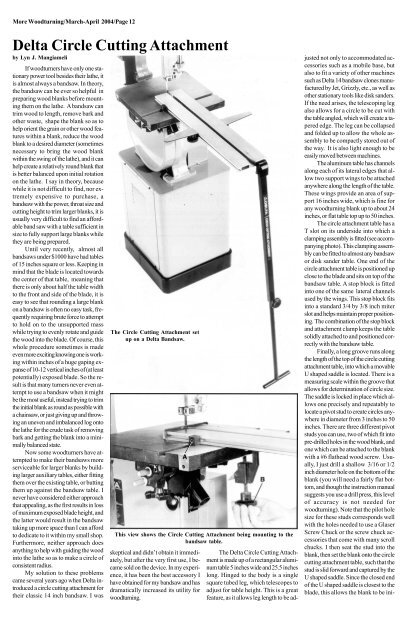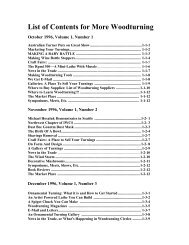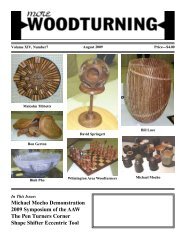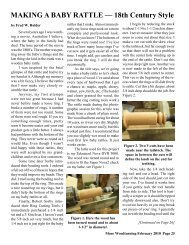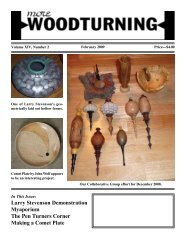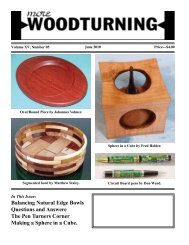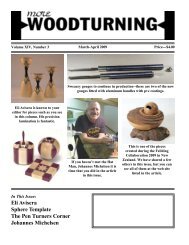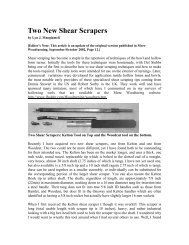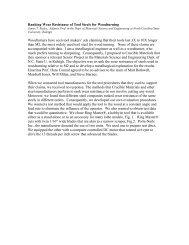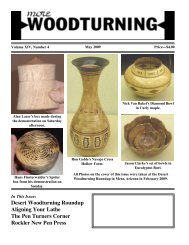Delta Circle Cutting Attachment - More Woodturning
Delta Circle Cutting Attachment - More Woodturning
Delta Circle Cutting Attachment - More Woodturning
You also want an ePaper? Increase the reach of your titles
YUMPU automatically turns print PDFs into web optimized ePapers that Google loves.
<strong>More</strong> <strong>Woodturning</strong>/March-April 2004/Page 12<br />
<strong>Delta</strong> <strong>Circle</strong> <strong>Cutting</strong> <strong>Attachment</strong><br />
by Lyn J. Mangiameli<br />
If woodturners have only one stationary<br />
power tool besides their lathe, it<br />
is almost always a bandsaw. In theory,<br />
the bandsaw can be ever so helpful in<br />
preparing wood blanks before mounting<br />
them on the lathe. A bandsaw can<br />
trim wood to length, remove bark and<br />
other waste, shape the blank so as to<br />
help orient the grain or other wood features<br />
within a blank, reduce the wood<br />
blank to a desired diameter (sometimes<br />
necessary to bring the wood blank<br />
within the swing of the lathe), and it can<br />
help create a relatively round blank that<br />
is better balanced upon initial rotation<br />
on the lathe. I say in theory, because<br />
while it is not difficult to find, nor extremely<br />
expensive to purchase, a<br />
bandsaw with the power, throat size and<br />
cutting height to trim larger blanks, it is<br />
usually very difficult to find an affordable<br />
band saw with a table sufficient in<br />
size to fully support large blanks while<br />
they are being prepared.<br />
Until very recently, almost all<br />
bandsaws under $1000 have had tables<br />
of 15 inches square or less. Keeping in<br />
mind that the blade is located towards<br />
the center of that table, meaning that<br />
there is only about half the table width<br />
to the front and side of the blade, it is<br />
easy to see that rounding a large blank<br />
on a bandsaw is often no easy task, frequently<br />
requiring brute force to attempt<br />
to hold on to the unsupported mass<br />
while trying to evenly rotate and guide<br />
the wood into the blade. Of course, this<br />
whole procedure sometimes is made<br />
even more exciting knowing one is working<br />
within inches of a huge gaping expanse<br />
of 10-12 vertical inches of (at least<br />
potentially) exposed blade. So the result<br />
is that many turners never even attempt<br />
to use a bandsaw when it might<br />
be the most useful, instead trying to trim<br />
the initial blank as round as possible with<br />
a chainsaw, or just giving up and throwing<br />
an uneven and imbalanced log onto<br />
the lathe for the crude task of removing<br />
bark and getting the blank into a minimally<br />
balanced state.<br />
Now some woodturners have attempted<br />
to make their bandsaws more<br />
serviceable for larger blanks by building<br />
larger auxiliary tables, either fitting<br />
them over the existing table, or butting<br />
them up against the bandsaw table. I<br />
never have considered either approach<br />
that appealing, as the first results in loss<br />
of maximum exposed blade height, and<br />
the latter would result in the bandsaw<br />
taking up more space than I can afford<br />
to dedicate to it within my small shop.<br />
Furthermore, neither approach does<br />
anything to help with guiding the wood<br />
into the lathe so as to make a circle of<br />
consistent radius.<br />
My solution to these problems<br />
came several years ago when <strong>Delta</strong> introduced<br />
a circle cutting attachment for<br />
their classic 14 inch bandsaw. I was<br />
The <strong>Circle</strong> <strong>Cutting</strong> <strong>Attachment</strong> set<br />
up on a <strong>Delta</strong> Bandsaw.<br />
This view shows the <strong>Circle</strong> <strong>Cutting</strong> <strong>Attachment</strong> being mounting to the<br />
bandsaw table.<br />
skeptical and didn’t obtain it immediately,<br />
but after the very first use, I became<br />
sold on the device. In my experience,<br />
it has been the best accessory I<br />
have obtained for my bandsaw and has<br />
dramatically increased its utility for<br />
woodturning.<br />
The <strong>Delta</strong> <strong>Circle</strong> <strong>Cutting</strong> <strong>Attachment</strong><br />
is made up of a rectangular aluminum<br />
table 5 inches wide and 25.5 inches<br />
long. Hinged to the body is a single<br />
square tubed leg, which telescopes to<br />
adjust for table height. This is a great<br />
feature, as it allows leg length to be ad-<br />
justed not only to accommodated accessories<br />
such as a mobile base, but<br />
also to fit a variety of other machines<br />
such as <strong>Delta</strong> 14 bandsaw clones manufactured<br />
by Jet, Grizzly, etc., as well as<br />
other stationary tools like disk sanders.<br />
If the need arises, the telescoping leg<br />
also allows for a circle to be cut with<br />
the table angled, which will create a tapered<br />
edge. The leg can be collapsed<br />
and folded up to allow the whole assembly<br />
to be compactly stored out of<br />
the way. It is also light enough to be<br />
easily moved between machines.<br />
The aluminum table has channels<br />
along each of its lateral edges that allow<br />
two support wings to be attached<br />
anywhere along the length of the table.<br />
These wings provide an area of support<br />
16 inches wide, which is fine for<br />
any woodturning blank up to about 24<br />
inches, or flat table top up to 50 inches.<br />
The circle attachment table has a<br />
T slot on its underside into which a<br />
clamping assembly is fitted (see accompanying<br />
photo). This clamping assembly<br />
can be fitted to almost any bandsaw<br />
or disk sander table. One end of the<br />
circle attachment table is positioned up<br />
close to the blade and sits on top of the<br />
bandsaw table. A stop block is fitted<br />
into one of the same lateral channels<br />
used by the wings. This stop block fits<br />
into a standard 3/4 by 3/8 inch miter<br />
slot and helps maintain proper positioning.<br />
The combination of the stop block<br />
and attachment clamp keeps the table<br />
solidly attached to and positioned correctly<br />
with the bandsaw table.<br />
Finally, a long groove runs along<br />
the length of the top of the circle cutting<br />
attachment table, into which a movable<br />
U shaped saddle is located. There is a<br />
measuring scale within the groove that<br />
allows for determination of circle size.<br />
The saddle is locked in place which allows<br />
one precisely and repeatably to<br />
locate a pivot stud to create circles anywhere<br />
in diameter from 3 inches to 50<br />
inches. There are three different pivot<br />
studs you can use, two of which fit into<br />
pre-drilled holes in the wood blank, and<br />
one which can be attached to the blank<br />
with a #6 flathead wood screw. Usually,<br />
I just drill a shallow 3/16 or 1/2<br />
inch diameter hole on the bottom of the<br />
blank (you will need a fairly flat bottom,<br />
and though the instruction manual<br />
suggests you use a drill press, this level<br />
of accuracy is not needed for<br />
woodturning). Note that the pilot hole<br />
size for these studs corresponds well<br />
with the holes needed to use a Glaser<br />
Screw Chuck or the screw chuck accessories<br />
that come with many scroll<br />
chucks. I then seat the stud into the<br />
blank, then set the blank onto the circle<br />
cutting attachment table, such that the<br />
stud is slid forward and captured by the<br />
U shaped saddle. Since the closed end<br />
of the U shaped saddle is closest to the<br />
blade, this allows the blank to be ini-
<strong>More</strong> <strong>Woodturning</strong>/March-April 2004/Page 13<br />
A New Type of Woodworking Magazine<br />
This view shows the attaching clamp about to be engaged to hole the<br />
accessory to the bandsaw table.<br />
This view shows the “U” shaped piece that fits into the slot in the<br />
accessory table to set the diameter of the disk to be cut by the bandsaw.<br />
by Fred Holder<br />
I received a call from Chris<br />
DeHut, editor of “Woodworking at<br />
Home” magazine, which is not really a<br />
magazine but a DVD that has print stories<br />
that you can print out on your computer<br />
printer and movies that you can<br />
watch on your computer or on your<br />
Television set. You do have to have a<br />
DVD drive for your computer and a<br />
DVD for your television to use this<br />
magazine.<br />
It seems that Dick Sing had recommended<br />
that Chris advertise in <strong>More</strong><br />
<strong>Woodturning</strong>. After talking with Chris,<br />
I decided I would like to subscribe to<br />
his “magazine”. He suggested an exchange<br />
and the deal was struck. He sent<br />
me Issue Number 7, which was December<br />
2003.<br />
This is a new technology that I<br />
found very interesting. My wife and I<br />
viewed the DVD on our television set<br />
and then I printed out a couple of the<br />
transcriptions with pictures and drawings.<br />
On this basis, we decided to get<br />
the back issues and I subsquently ordered<br />
them.<br />
Even though I do not do general<br />
woodworking, I found the entire DVD<br />
to be of interest.<br />
The first part of Issue #7, was<br />
called the Construction Zone with Chris<br />
DeHut and covered two projects:<br />
(1) A set of wall hung storage<br />
cabinets with pull-out vertical drawers.<br />
Each drawer had shelves in it for storage.<br />
(2) An elegant CD/DVD storage<br />
cabinet. A perfect desk top accessory<br />
to organize your growing collection of<br />
Woodworking at Home DVD’s it says<br />
at their web site.<br />
The next segment was a two part<br />
construction story of a high-end miter<br />
saw stand. This was interesting and I<br />
especially liked the fold down “wings”<br />
that are designed to use to hold long<br />
pieces of wood for cutting on the miter<br />
saw.<br />
The next segment was devoted to<br />
sharpening your carving tools with David<br />
Reilly. This was an interesting segment<br />
and I learned a bit about sharpening carving<br />
tools that I did not already know. This<br />
section was very interesting and could<br />
be somewhat applicable to sharpening<br />
turning tools, especially if you hand<br />
sharpen on a stone.<br />
The next section, “A turn for the<br />
better:” with Dick Sing covers the making<br />
of a bottle with a brush to hold your<br />
finish. Dick shows you how to do this in<br />
easy step by step processes. I’m sure<br />
this would be a handy item to have in<br />
any workshop and very useful in a<br />
woodturner’s shop.<br />
The next section is titled “Bragging<br />
Rights--Viewer Gallery” in which Adolph<br />
Schnieder shows you some of the very<br />
nice furniture that he has made.The highlight<br />
was a fantastic dressing table.<br />
The next section was Tool Demos,<br />
which included two items:<br />
(1) A Table Saw blade cover by<br />
Exaktor Tools Inc. which looked neat<br />
and provided a way to carry away the<br />
dust from sawing.<br />
(2) The second was a Laser Guide<br />
by Laserkerf for the chop saw or miter<br />
saw. This device projected a laser beam<br />
on either side of where the saw blade<br />
would cut. Thus making it very easy to<br />
cut on the line.<br />
Contact information is:<br />
Woodworking at Home<br />
SoftWerks International Inc.<br />
2413 W Algonquin Rd. PMB #425<br />
Algonquin, IL 60102<br />
TEL: 847-854-2381<br />
FAX: 847-854-2382<br />
Web Site: www.woodworkingathome.com<br />
This view shows the three different pivot studs you can use, two of which<br />
fit into pre-drilled holes in the wood blank, and one which can be attached<br />
to the blank with a #6 flathead wood screw.<br />
tially located back from the pivot point,<br />
than spiraled into the blade until the correct<br />
diameter is achieved when the pivot<br />
stud is fully against the closed end of<br />
the saddle.<br />
All of this has taken much longer<br />
to describe than is required to set up and<br />
put the circle cutting attachment into<br />
sevice. In actual use, the circle cutting<br />
attachment works beautifully. It provides<br />
sufficient table support, and allows one<br />
to position the wings so that the support<br />
surface is near the pivot point, no longer<br />
does one have to struggle to keep the<br />
blank balanced and level. The <strong>Circle</strong><br />
<strong>Cutting</strong> <strong>Attachment</strong> makes for much<br />
easier control of feed into the blade, and<br />
much safer manipulation of the blank.<br />
The central pivot point, and full table<br />
support means one can grasp a blank well<br />
away from the blade. I find there is far<br />
less binding on the blade, resulting in a<br />
smoother and faster cutting action, compared<br />
to trying to free hand a circle. Needless<br />
to say, the central pivot point insures<br />
a constant radius, which results in a perfect<br />
circle and better balance to the turning<br />
blank.<br />
When done, the circle cutting attachment<br />
can be collapsed and folded up to<br />
wait unobtrusively alongside the bandsaw<br />
until needed again, at which time it can<br />
be remounted in literally a few minutes.<br />
For those who have a <strong>Delta</strong> 14 inch style<br />
bandsaw, this accessory has my highest<br />
recommendation. Its cost from Highland<br />
Hardware, the only stocking supplier that<br />
I am aware of, is $100.<br />
(Note: Photos are from the <strong>Delta</strong> manual)<br />
Big Tree Tools, Inc.<br />
THE BEST Sharpening Machine<br />
for Woodturners<br />
• extremely fast & accurate<br />
• 1000 sharpenings/inch<br />
• sharpen in less than 10 sec.<br />
• 150 grit 4X36 belt<br />
• $375.00 postpaid<br />
• check, please<br />
258 Breezy Hill Rd<br />
Wilmot, NH 03287<br />
Phone 603-735-5882<br />
1-888-Turning<br />
big@proctornet.com<br />
www.bigtreetools.com<br />
If you have a tip worth sharing with our<br />
readers, submit it to us and earn $10.00 if it is<br />
accepted for publication.


